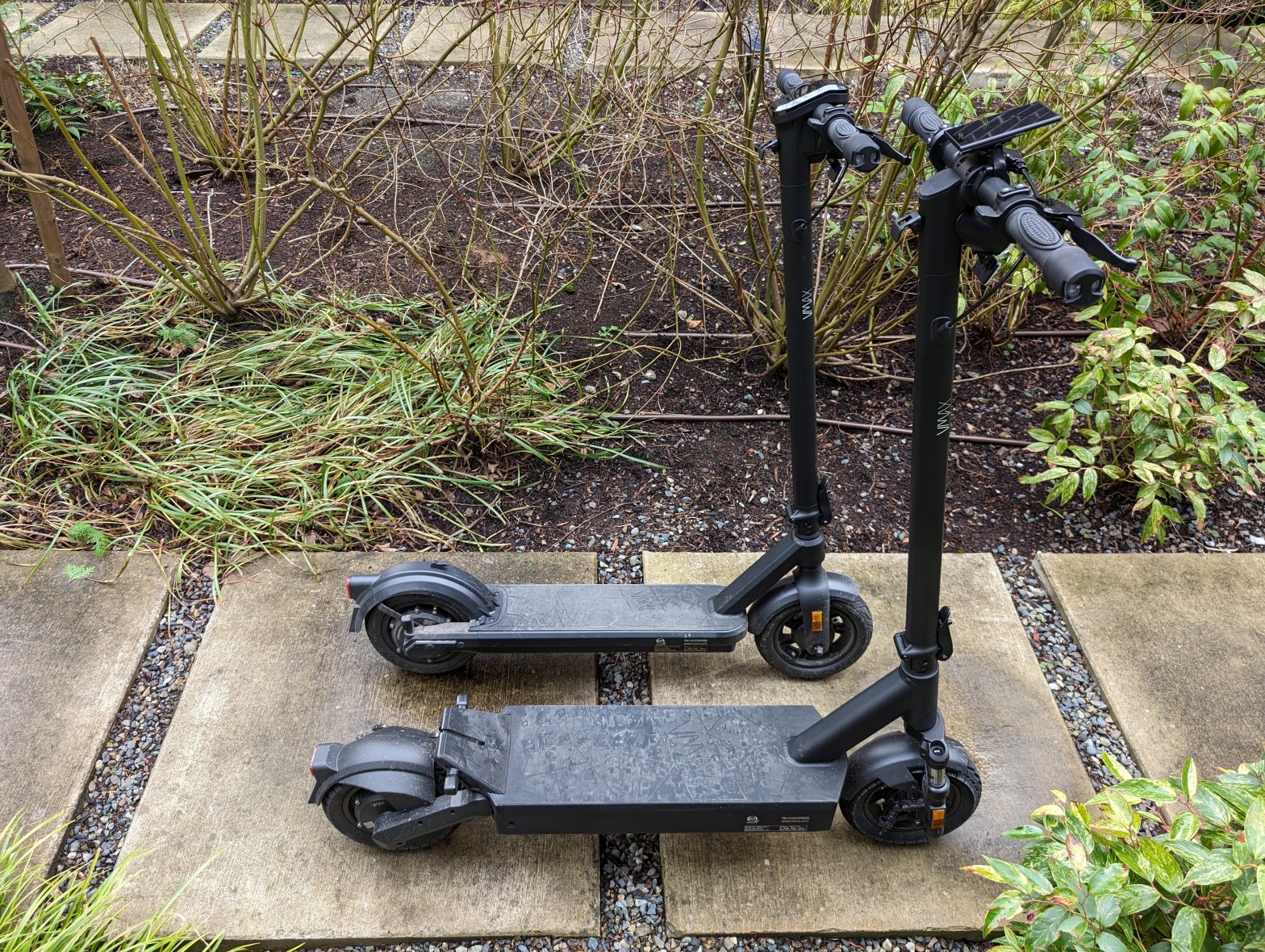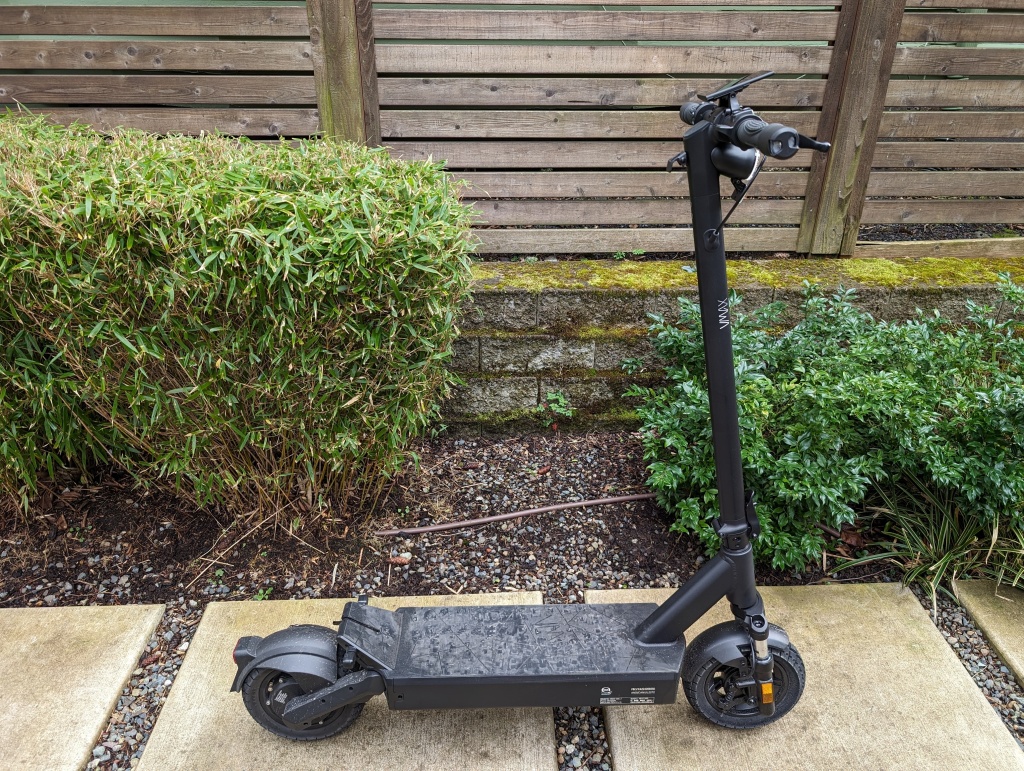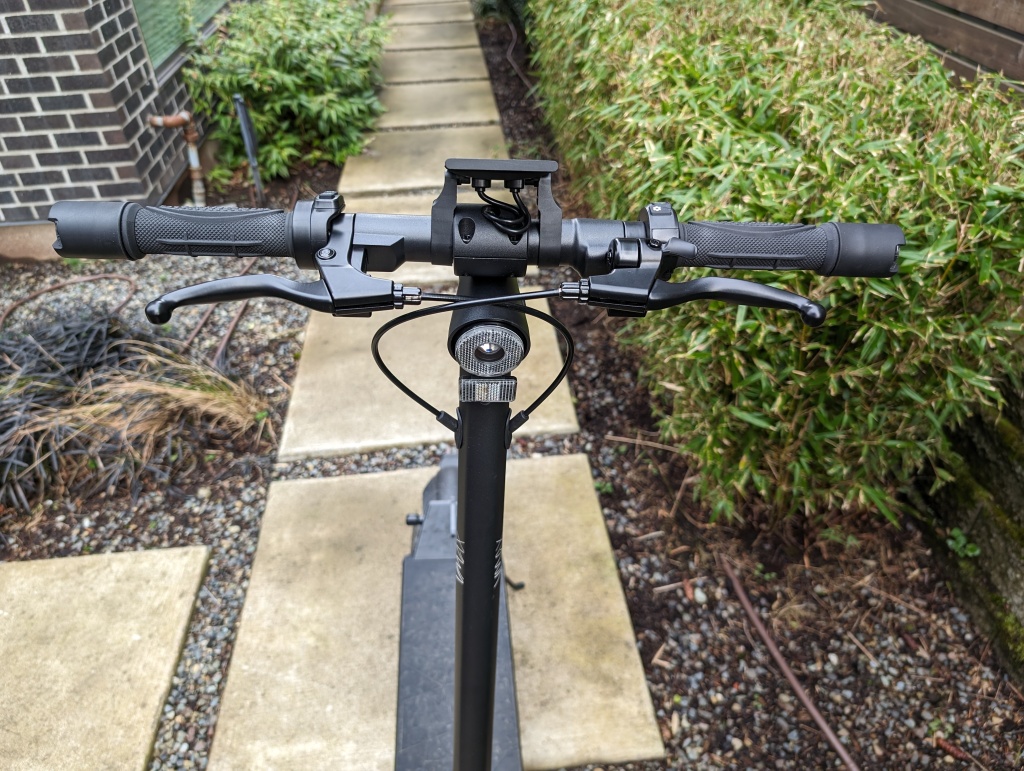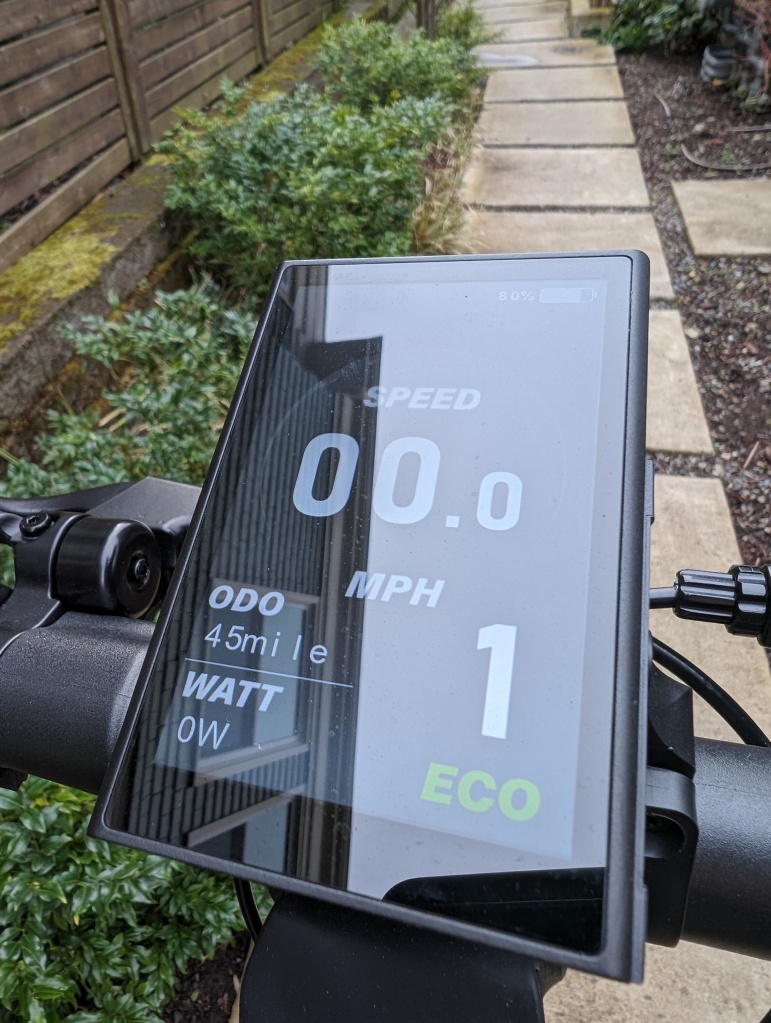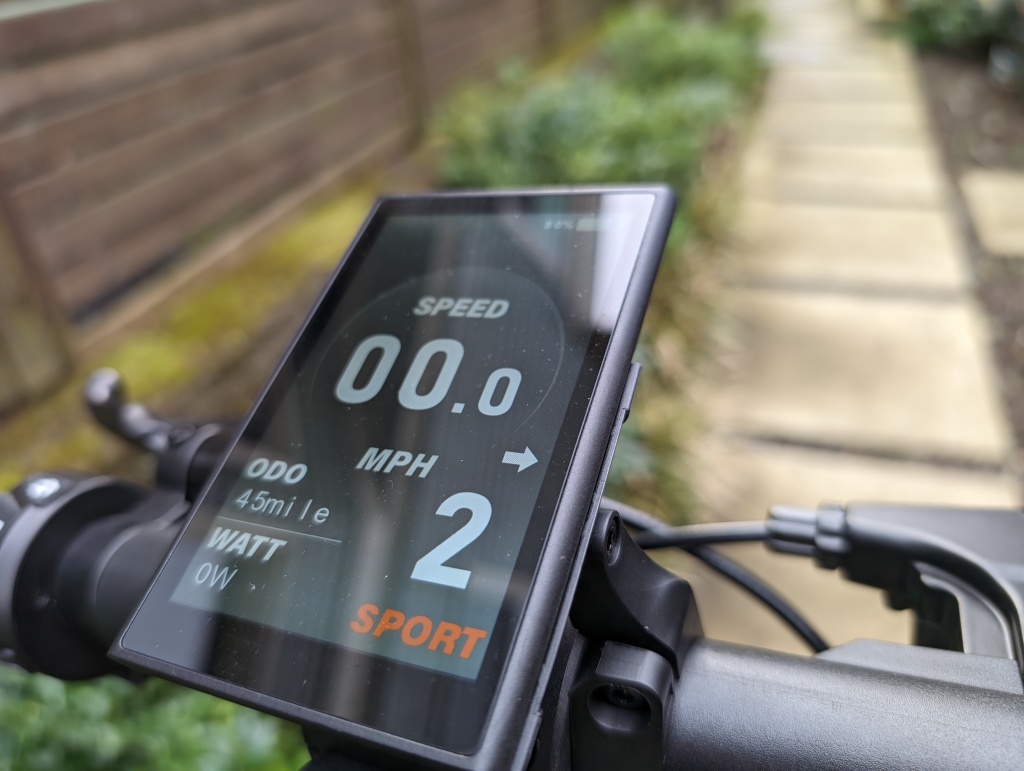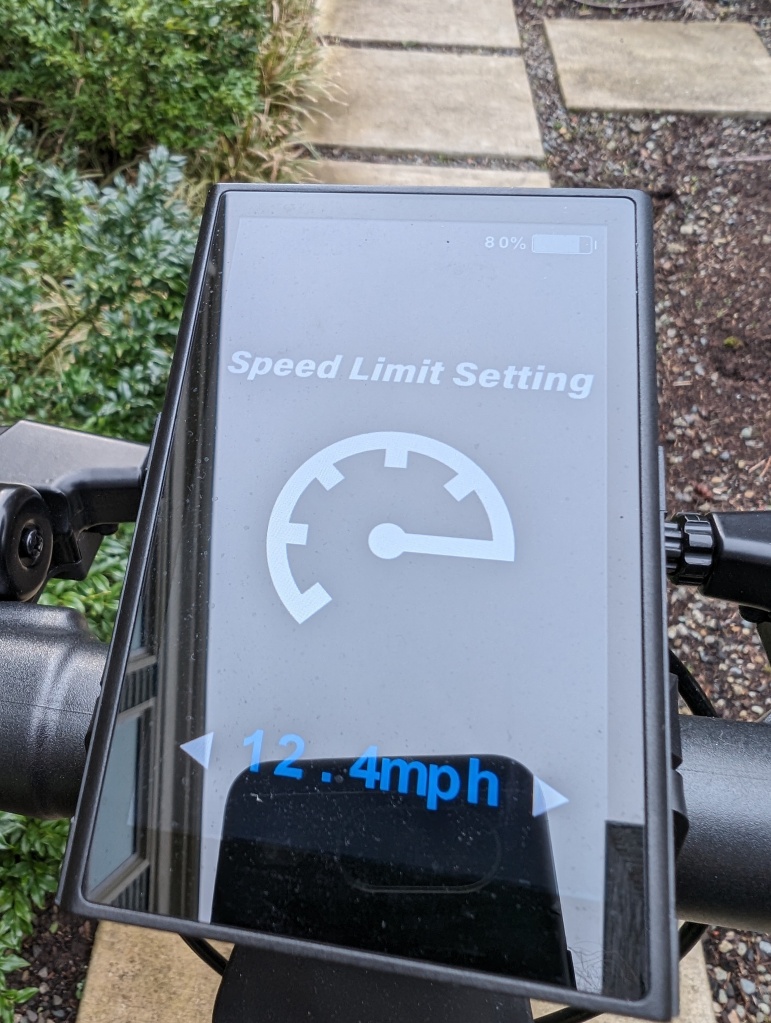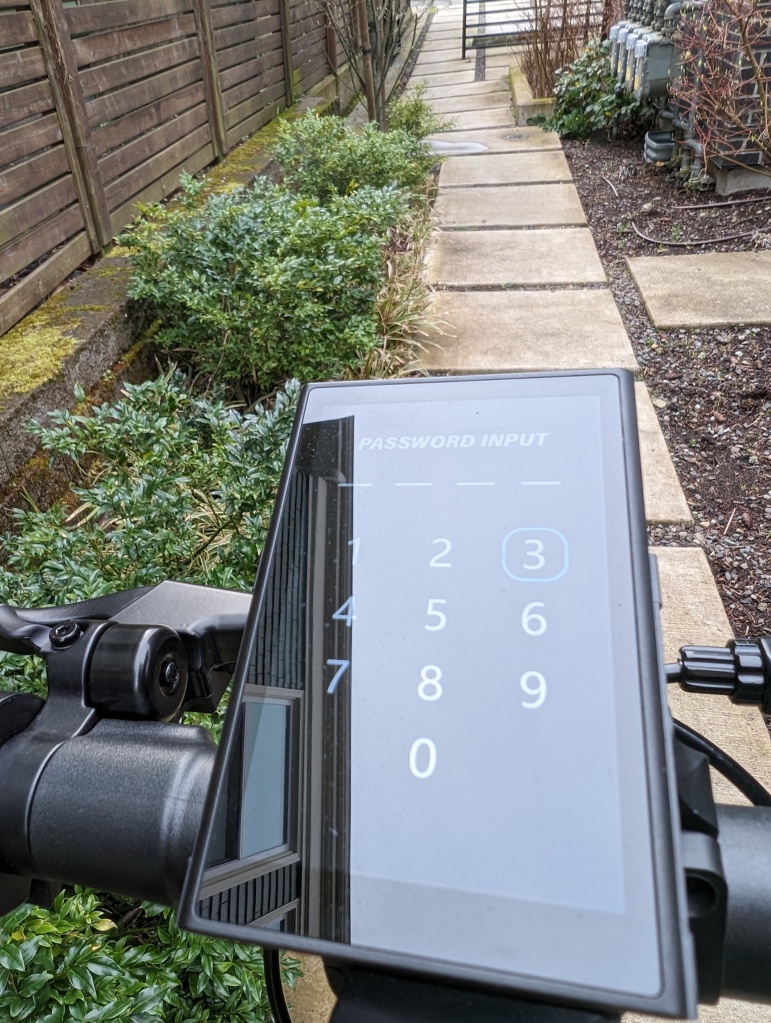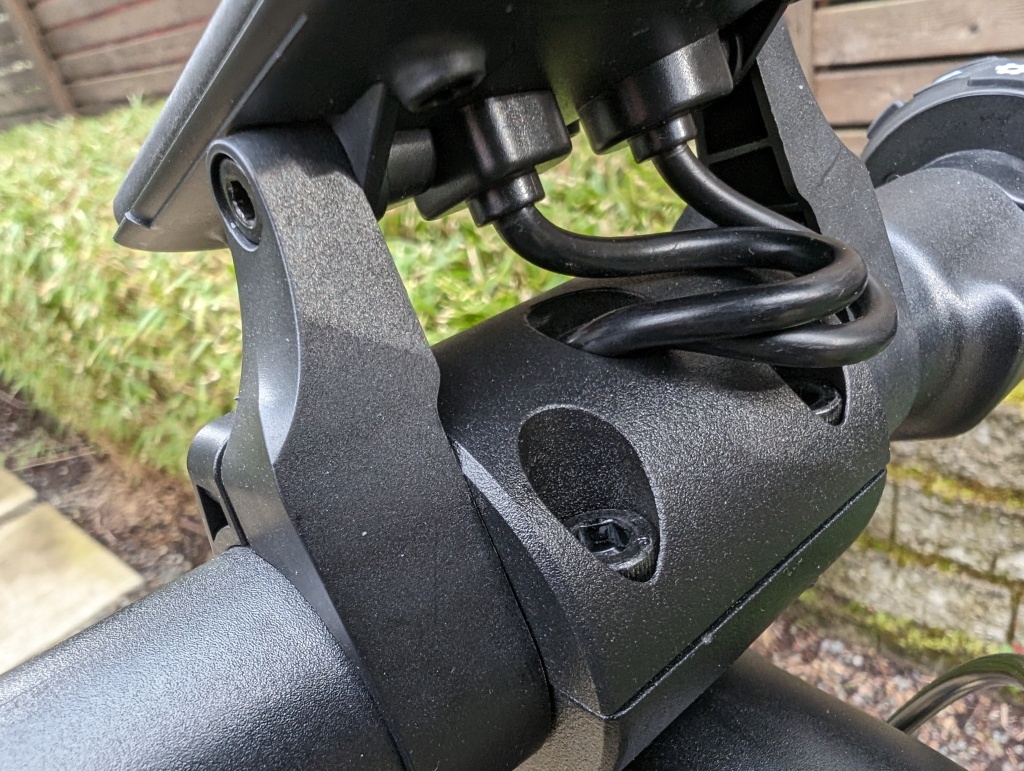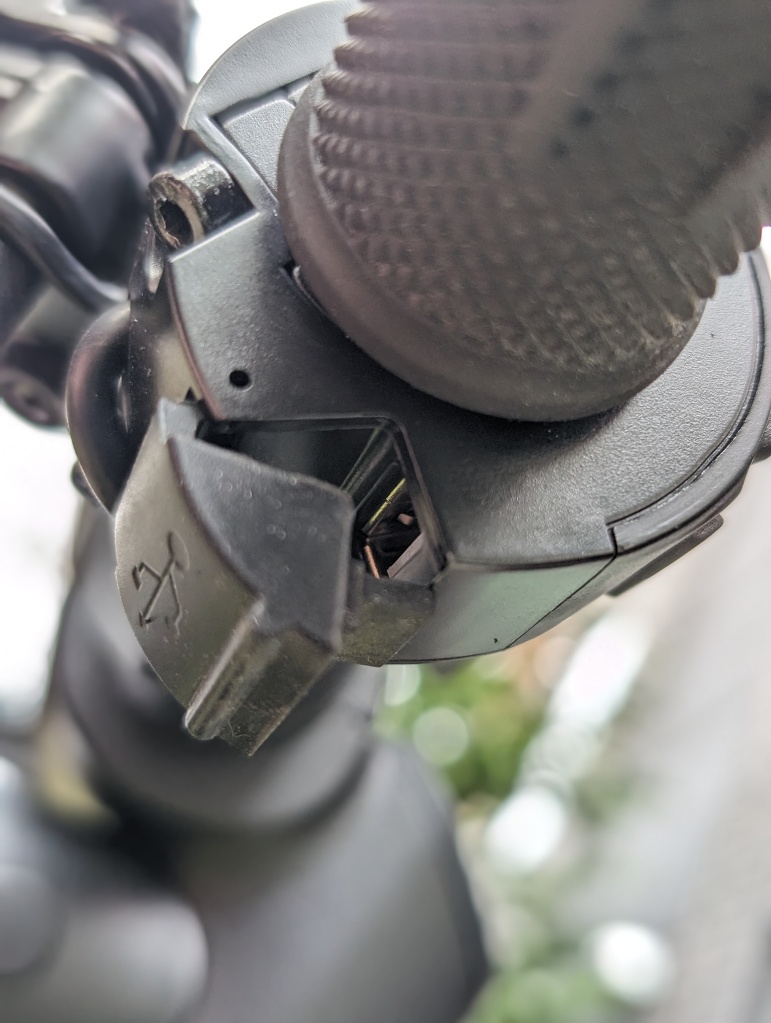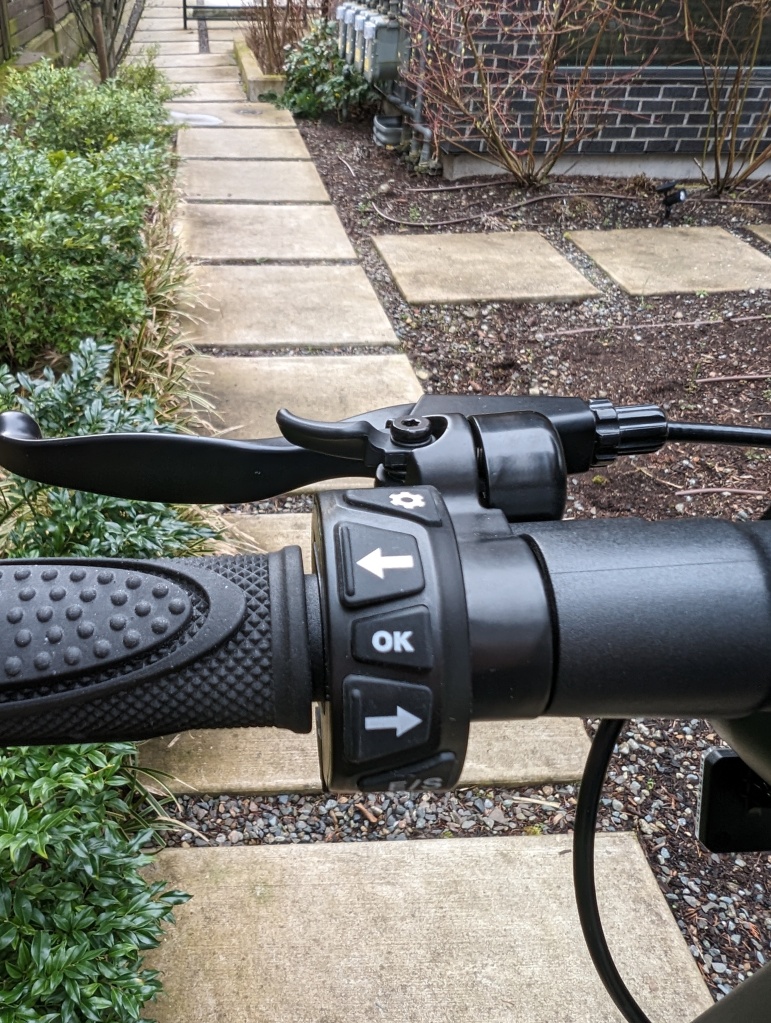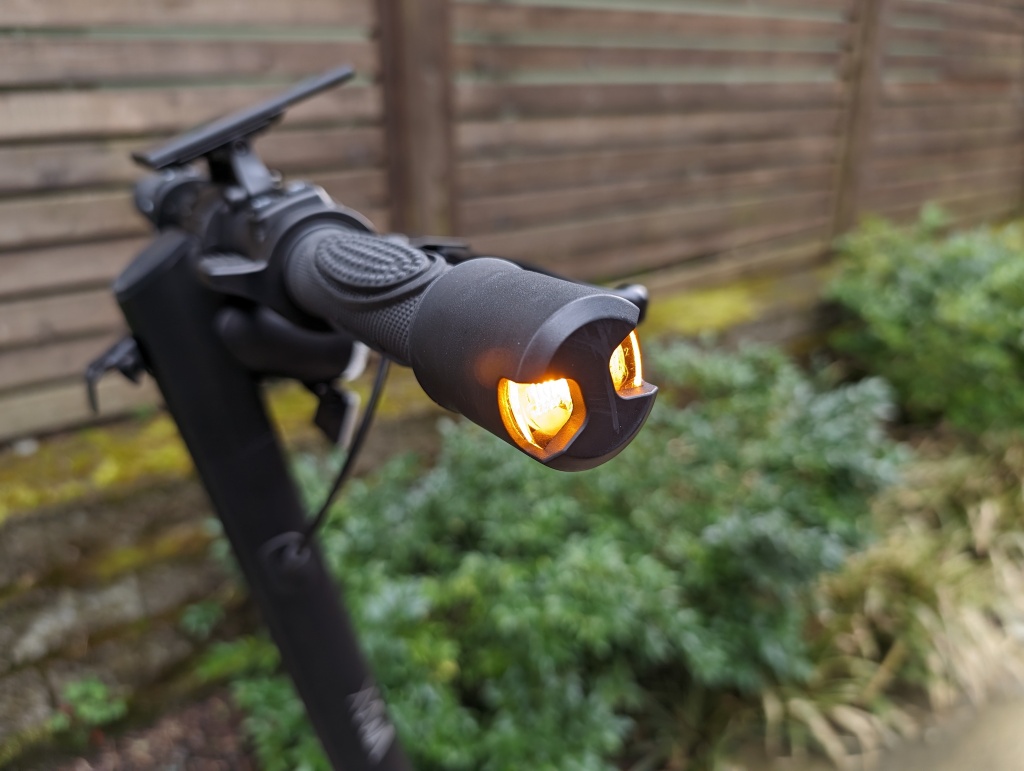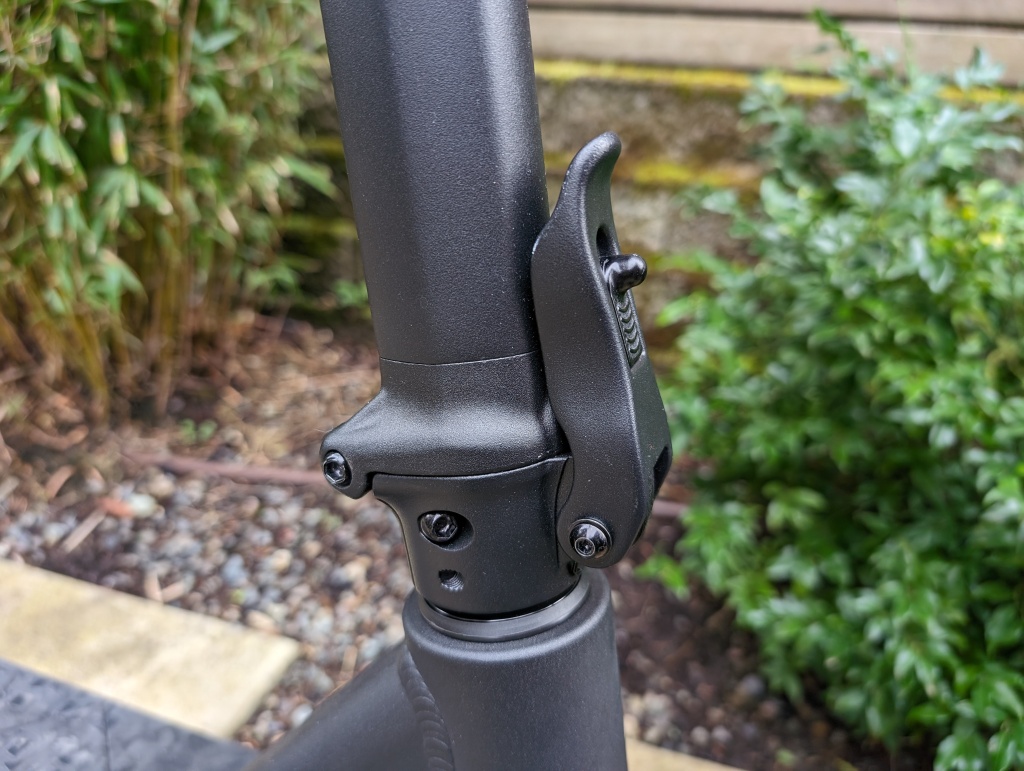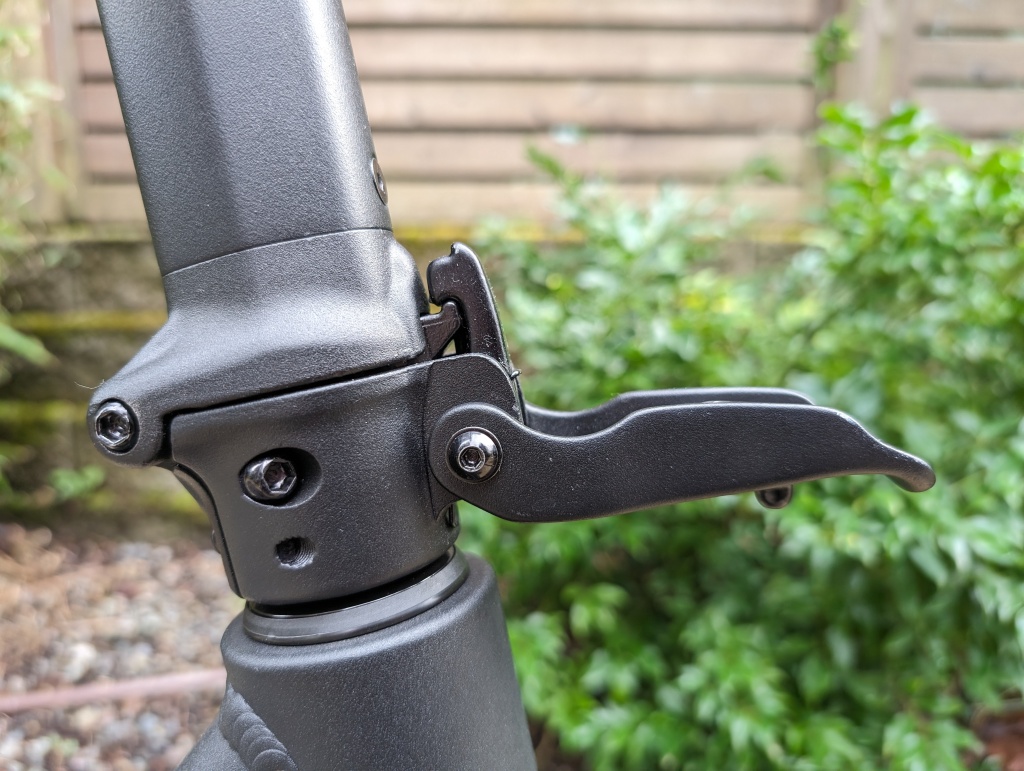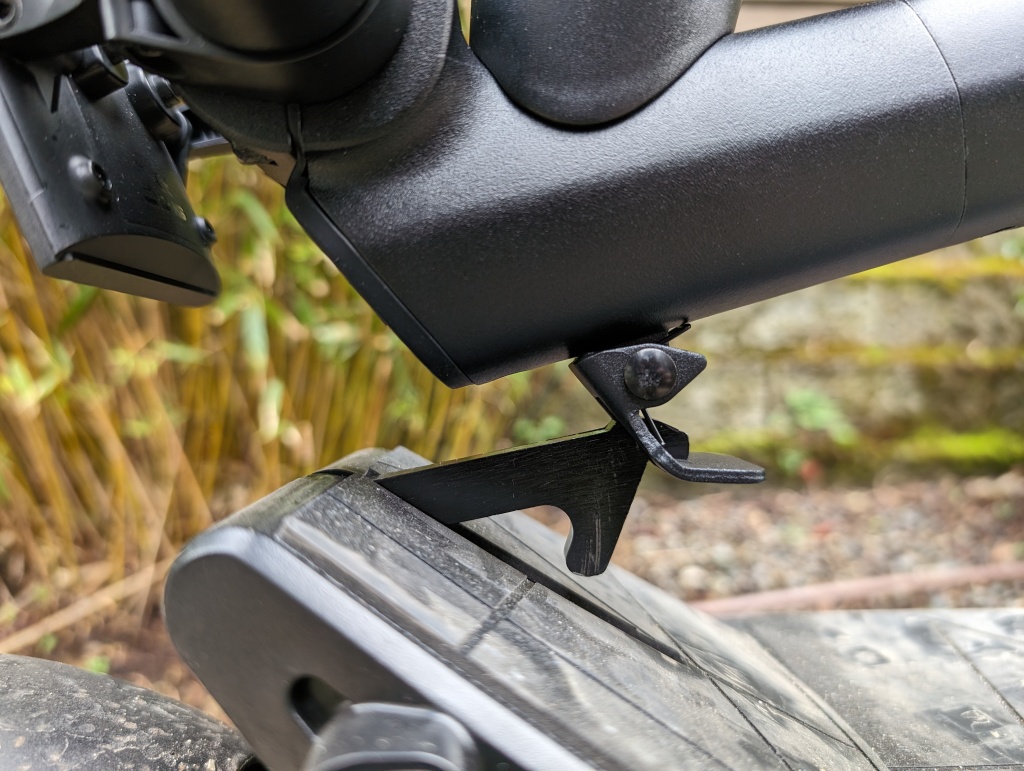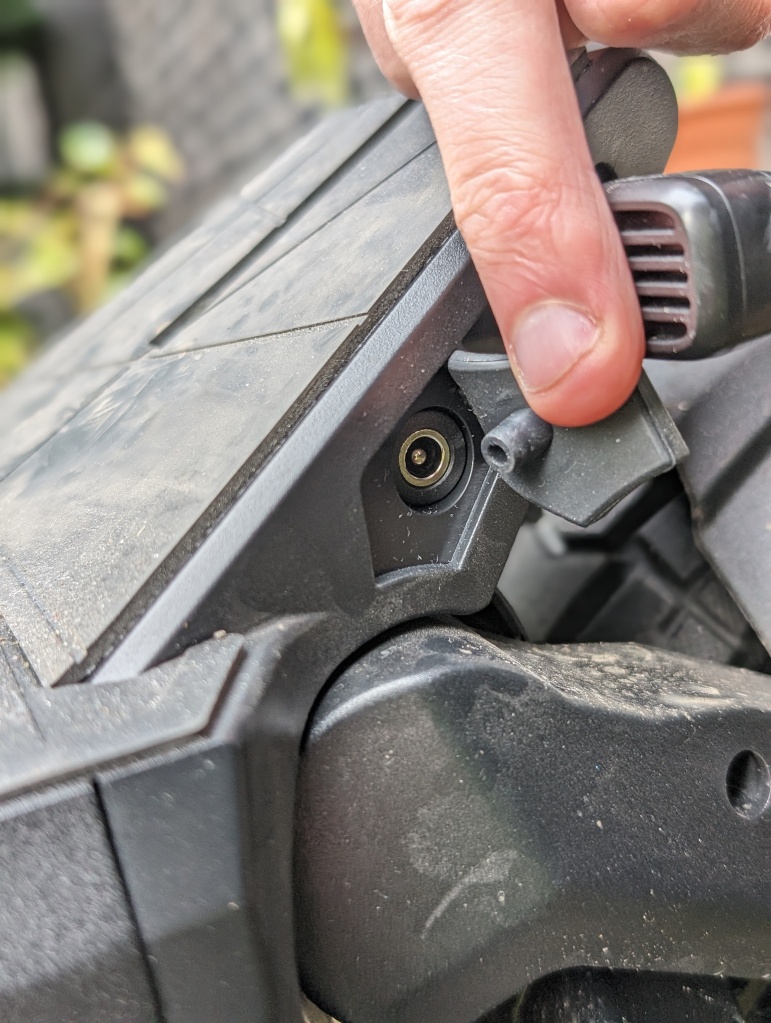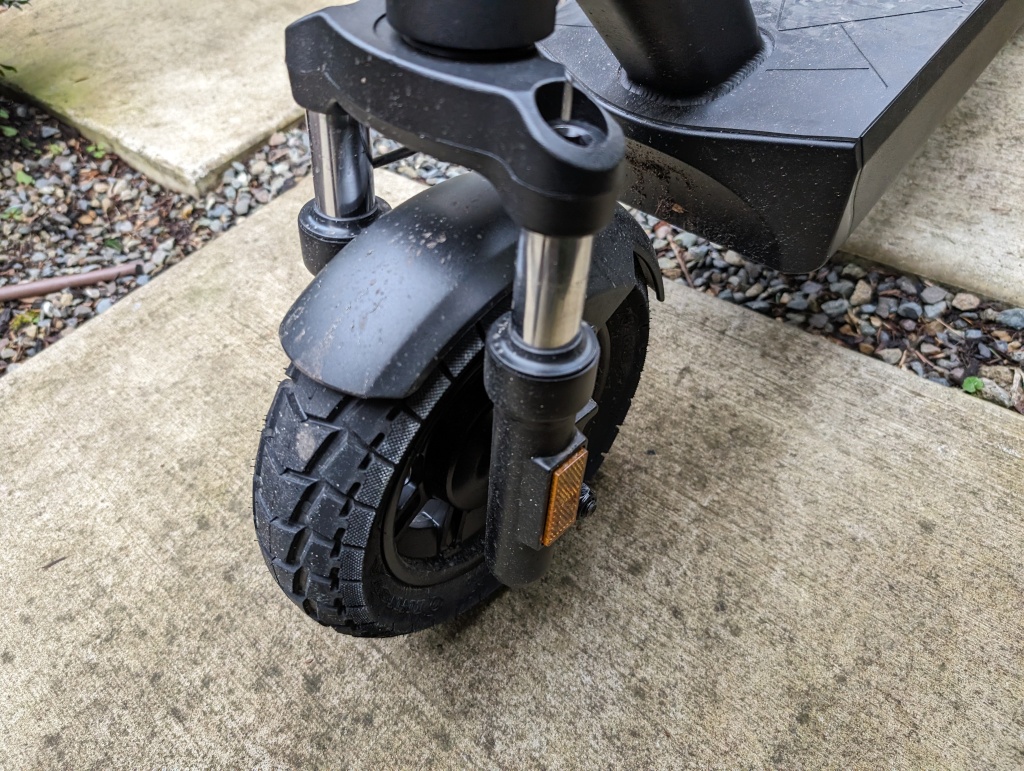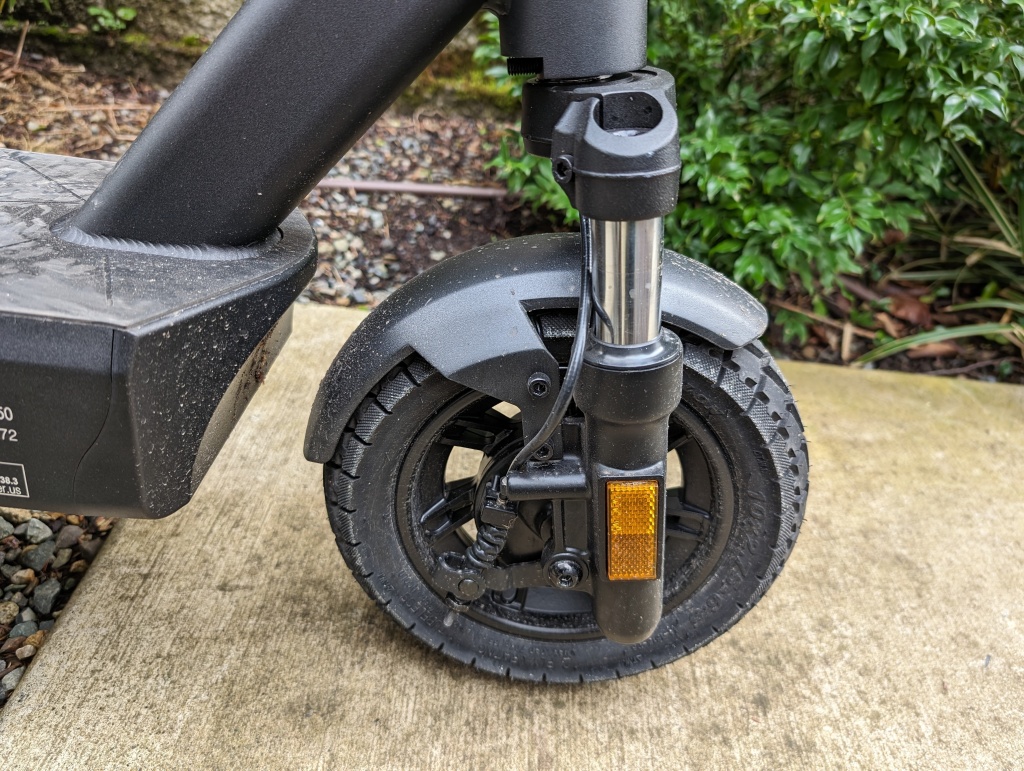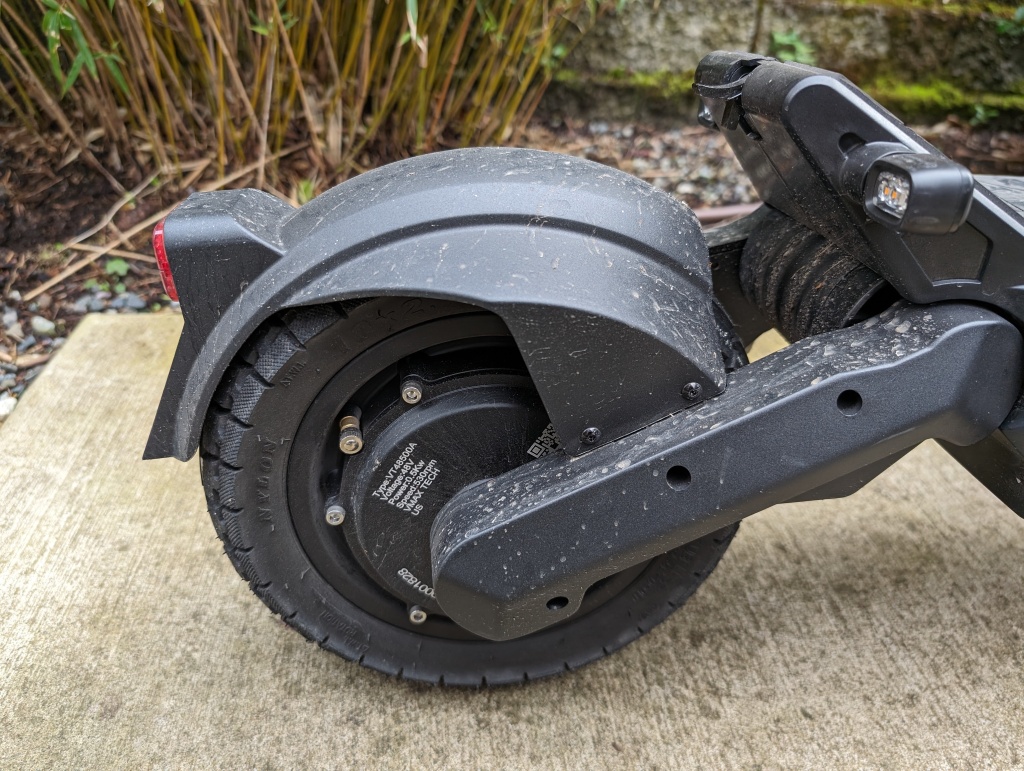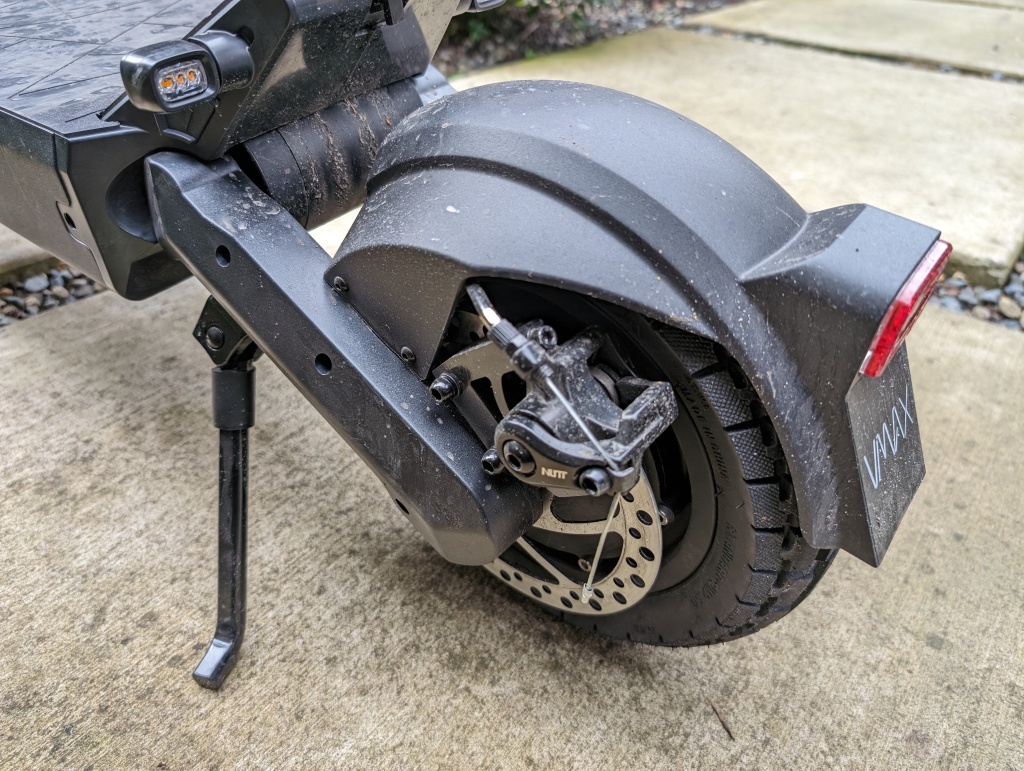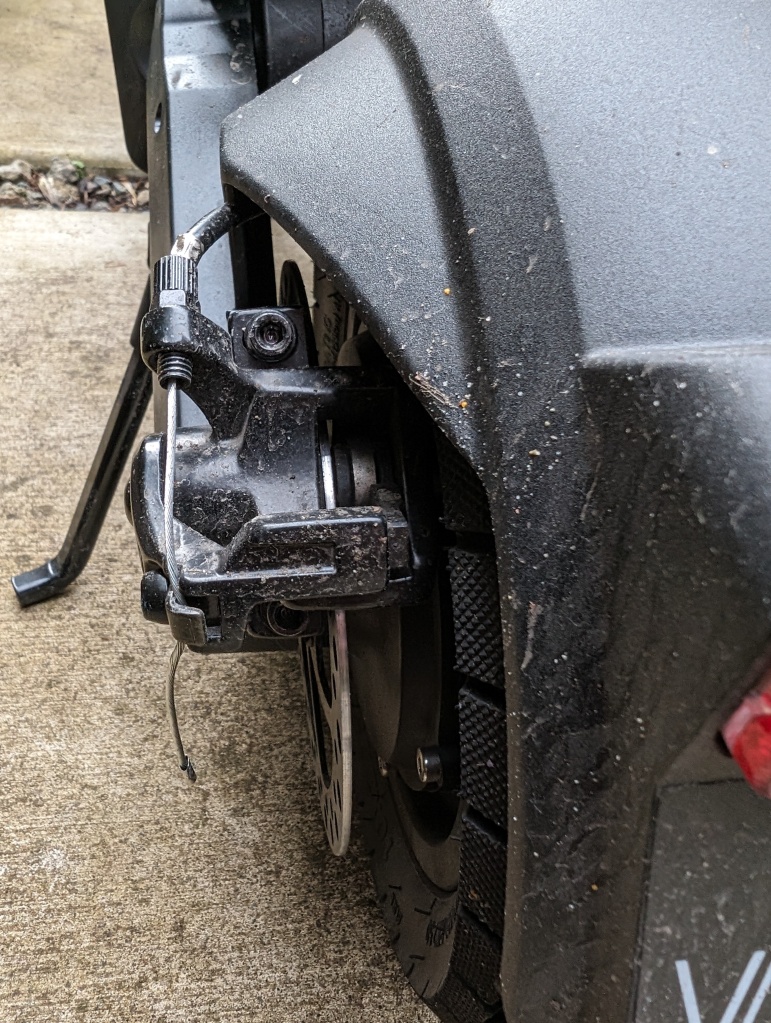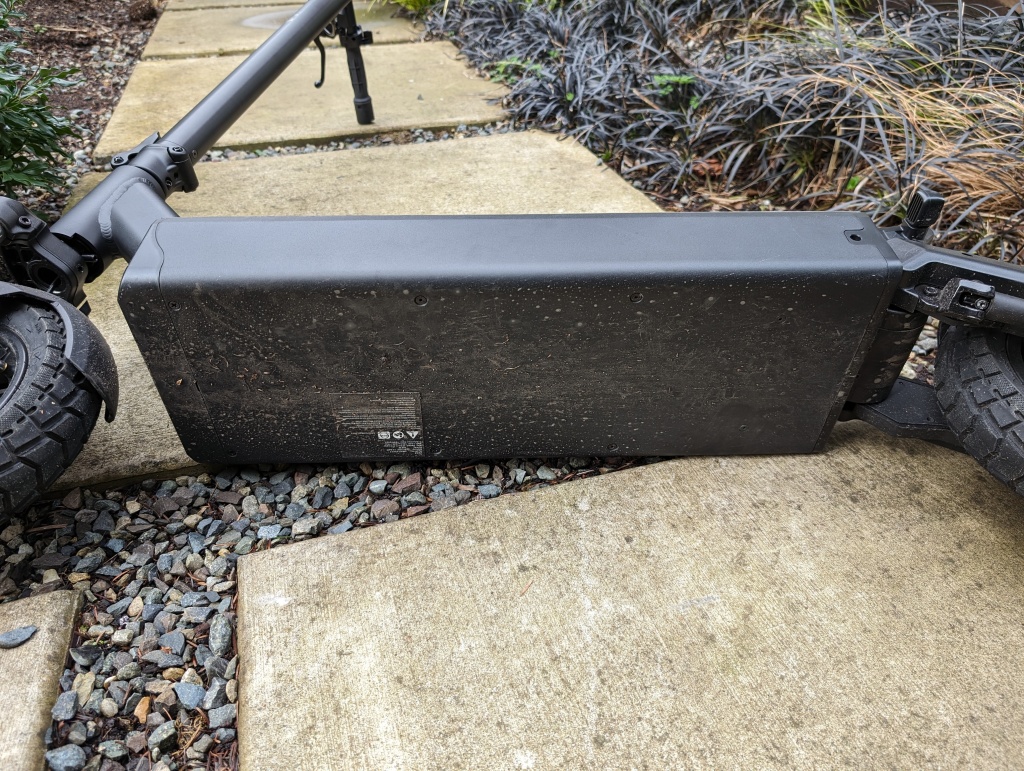*Note: This is NOT a paid review, nor did I receive anything in exchange. This article contains NO affiliate links.
If you’ve never considered the humble electric scooter before, consider it now! Scooting is a super fun and convenient way to travel short and medium distances. Think about it:
- It’s exhilarating! Feel the wind in your hair!
- Way cheaper than a car! Think 1-10% of the cost.
- No need to buy gas! You can charge at home with a regular outlet.
- Can be faster than driving! You can ride on walking/biking-only paths, and bike lanes let you bypass traffic. You can even cross with pedestrians at crosswalks!
- No need to find parking! You can keep it in your house, under your desk, or even with you in the grocery store! Just plop your basket on it and walk it around!
- Easier than biking! Especially for steep hills.
- More compact than a bike! Great if you don’t have a lot of storage space. Scooters can easily fit under a desk or in the trunk of a car.
If you’re curious, maybe try renting one some time. If you like it and want to buy your own, the VMAX models in this article are great scooters for beginners! Just make sure to start slow, ride safe, and get yourself a good full-face helmet if you plan to ride often. 🙂
The Need
There’s not many reviews out there on the VX4 and VX2 Pro e-scooters from VMAX, the Swiss electric mobility brand who only just made their entry into the U.S. market in 2023. Which is sad, because their offerings look to be amongst the cream of the crop! Alas, when I was searching for a new electric kickscooter a few months ago, I agonized over whether to drop over $1000 on a brand that almost nobody in the U.S. had ever heard of.
But… I gave in and opened my wallet anyway. And luckily, it worked out! I’ve been able to thoroughly test both the VX4 and the VX2 Pro over the past several weeks, and now I’ve decided to gift this honest, comprehensive review to the scooter community. Hopefully it makes someone else’s purchasing decision easier!
The Search
When I started my search for the perfect e-scooter, these were my requirements:
- UL 2272-certified (so the batteries don’t explode and burn my house down)
- 20mph minimum speed
- Ability to go up steep hills
- Suspension (to smooth out the bumps)
- Pneumatic tires (solid tires give a super bumpy ride and have poor traction)
- At least 10″ tires (for safety; easier to roll over smaller potholes)
- IPX6 water resistance
After dozens of hours of research done over the course of weeks, the VMAX VX4 was literally the only scooter I could find that met all of these requirements. Very few scooters are UL-certified, and those that are generally either have no suspension or a low IP rating (which matters a lot to me because I live in a very rainy area). And that doesn’t even touch on the other requirements! So I was thrilled when I found the VMAX VX4.
But then why do I also have a VX2 Pro? Well because when I ordered it in November of 2023, they were out of stock… and I wouldn’t end up receiving my VX4 until January. Then in January, they let me know that they got delayed and I wouldn’t receive it until March! Luckily, the customer support was very helpful and offered to send me a cheaper model, the VX2 Pro, until I received the VX4. So I ended up getting to try out both! I now have 107 miles on the VX2 Pro and 56 miles on the VX4, so I’m ready to give my review!
The VMAX Offerings
In order of ascending expense, their in-house scooter offerings include:
Yeah, the numbers are all over the place! They also sell the R40 Pro and R55 Pro, but from what I have read, they are rebranded Kugoo scooters, which I was not interested in (lower IP rating and no turn signals). The VX4 was the only other one with suspension, so that was my first choice.
VX4 Photos
But the VMAX VX2 Pro is the next best thing! For the most part, the VX4 is just slightly better than VX2 Pro in most ways.
VX2 Pro Photos
Here’s a quick comparison table of the high-level specs and features. Note that both models come with 3 different battery/range options (LT, ST, or GT):
| VMAX VX2 Pro (LT / ST / GT) | VMAX VX4 (LT / ST / GT) | |
| Price (as of 2024-03-24) | $700 / $800 / $1,000 | $1,200 / $1,300 / $1,450 |
| Range (miles) | 22 / 28 / 37 | 34 / 46 / 62 |
| Battery capacity (Ah) | 10.4 / 13 / 16 (48V) | 13 / 18.2 / 23.2 (48V) |
| UL 2272 certified? | Yes | Yes |
| Max speed | 24mph | 25mph |
| Motor nominal wattage | 500W | 500W |
| Motor peak wattage | 1300W | 1600W |
| Max incline gradient | 28% | 33% |
| IP water resistance rating | IPX6 | IPX6 |
| Turn signals? | Yes | Yes |
| Brake lights? | Yes | Yes |
| Front suspension? | No | Yes |
| Rear suspension? | No | Yes |
| Front brake | Drum | Drum |
| Rear brake | Regen | Regen + Disc |
| Weight | 43.2 / 45.0 / 45.0 lbs | 60.4 / 63.0 / 63.9 lbs |
| Dimensions (H × L × W) (website is wrong) | 47.5″ × 43.5″ × 22.8″ | 52.5″ × 48.0″ × 22.8″ |
| Max payload | 287 lbs | 330 lbs |
| Headlight brightness | 60 lux | 60 lux |
| Front wheel | 10″ tubeless tire | 10″ tubeless tire |
| Rear wheel | 10″ tubeless tire | 10″ tubeless tire |
| Folding? | Yes | Yes |
| USB port | No | Yes |
As you can see, they’re pretty similar (with the primary difference being the suspension). So for the highlights and lowlights, I’ll primarily focus on just one of them (the VX4) for now. Then there will be a secondary pro/con list at the end specifically comparing the VX4 to the VX2 Pro at a nitty-gritty level!
The VMAX VX4
Major Highlights
- Battery is UL 2272-certified.
- It’s less likely to explode and burn your house down!
- 25mph max speed.
- Good hill-climbing capability.
- I can go up steep hills (about 15% slope, according to ArcGIS) at about 10mph (with battery >70%). WAY better than rental scooters like Lime and Bird, which can’t do steep hills at all; I have to kick them up the hill manually. And I can do slight hills (~6%) at almost full speed (~24mph). Really steep hills (19%) can be done at about 7mph.
- Though a dual-motor scooter would do way better, this is still pretty reasonable! Most of my commute is 10% slope or less, so going slowly for the short steep segments isn’t too bad.
- Full suspension.
- You can roll over bumpy roads without feeling like you’re going to get bucked off!
- Pneumatic tires.
- Pneumatic (air-filled) for a smooth ride and good traction, compared to solid tires.
- Good tire size (10″ for both front and back).
- These make it easier to roll over small potholes and divots; smaller tires (like 8″) can get stuck in them more easily, increasing your chances of the scooter stopping suddenly and sending you flying over the handlebars.
- Though honestly, I would have preferred even slightly larger tires, like 11″ or 12″!
- IPX6 water resistance, so you can ride in the rain (just be careful!).
- Brake light.
- Doubles as a tail light; it shines red when the headlight is on, and becomes brighter when braking, just like a car.
- Turn signals.
- Both on the handlebars and above the back wheel. The handlebar turn signals shine bright yellow light 180° from front to back, so they can be seen from any angle.
- Good customer support.
- As mentioned earlier, they sent me a VX2 Pro (for free) to use temporarily since my VX4 order got delayed by a few months. And they even paid for the shipping both ways on the VX2 Pro!
- USB-A port to charge your phone or power other small peripherals (e.g. dashcam, lights, etc.).
- The max amperage is not specified, but I was able to get about 1.2A at 5V according to a cheap USB power meter. Not bad!
- I personally plugged in two sets of these USB LED strip lights (using a USB splitter) and stuck them to the stem and deck on each side of my scooter. They make it impossible for cars to miss me when riding at night, and plus they just look cool! They even turn on and off automatically with the scooter!
Minor Highlights
- The footboard/deck is large and comfortably fits even large feet and boots.
- Fairly high ground clearance, especially compared to the VX2 Pro.
- Rear disc brake.
- Though it’s not shown on the website, the VX4 actually has a disc brake on the back in addition to the regen brake. I suspect this was a recent addition to the VX4. It adds a bit of extra braking power, which is nice. Though it also interferes with the regen ability, so I actually loosened mine almost entirely so that the left brake lever basically only engages the regen brake. It doesn’t seem to noticeably improve battery life, but at least now I’m not wearing down a physical brake pad that I need to replace eventually. Note that I couldn’t fully disconnect it because otherwise the level is way too “floppy” without the cable for the disc brake attached, and it’s too easy to squeeze it. And even so, you have to squeeze the handle so far that it pinches your fingers unless you use all 4 of them, which is unsafe as it provides poor grip to the handlebars. I am considering modding the scooter with a dedicated regen brake “throttle” that looks identical to the one use for the regular throttle.
- Update: I have discovered why they added the rear disc brake; it’s because the regen brake will suddenly cut out entirely when braking very strongly at low speeds, e.g. around 10mph or below. It seems to only happen around maybe 10% of the time, and only for a split second, but when it happens, it’s still scary. So I have calibrated the disk brake such that it does not engage during light braking, but does engage during heavy braking, so that if the regen brake does cut out, the disk brake takes over and keeps the brakes going.
- Customizable settings:
- Can show speed in either km/h or mph.
- Can set a custom max speed (between 12.4mph and 21.7mph, or just 25mph).
- Can enable/disable kick-start in the settings, so you can choose whether you want the throttle to only work while the scooter is already going at least ~2mph (for safety, e.g. so you don’t accidentally accelerate suddenly while walking it down the hallway), or whether you want it to work immediately from a standstill.
- Functional charger.
- The light turns from red to green when charging is complete.
- Functional kickstand.
- Tire valves are easy to unscrew to check the pressure and refill as needed.
- After weeks of riding, the tires haven’t needed refilling even once (aside from immediately after checking the pressure, since that caused air to leak out).
- If I had wireless tire pressure monitors installed, I imagine I could go for quite a while without refilling the tires!
Neutral Points
- Decent battery life/range.
- The advertised range is 34 miles for the base (LT) VX4 model, which is what I have. However, that’s presumably for flat travel and on Eco mode. I travel in Sport mode (higher acceleration) and have a super hilly commute, which uses more power. I usually travel at 15-25mph, and have many starts and stops on my commute. I personally have noticed this discharge profile:
- Starts at 100%
- After commute to work (2.6 miles downhill): Still at 100%
- After commute to home (2.6 miles uphill): ~78%
- Back to work: ~62%
- Back to home: ~40%
- This means that the battery indicator isn’t quite perfect; the commute to work definitely uses power, as of the 4th line, but it doesn’t show any usage if it starts at 100%. Overall, based on this pattern, I would expect about 15 miles of range with intense usage, which is a bit under half of the advertised max range. Seems decent to me. If I needed more range, I could have just ordered the GT instead of the LT.
- The advertised range is 34 miles for the base (LT) VX4 model, which is what I have. However, that’s presumably for flat travel and on Eco mode. I travel in Sport mode (higher acceleration) and have a super hilly commute, which uses more power. I usually travel at 15-25mph, and have many starts and stops on my commute. I personally have noticed this discharge profile:
- Tubeless tires.
- Tubeless tires are tougher and less likely to leak, and also go flat less quickly if there is a leak.
- But the tubes on tubed tires are easier to replace. “Seating the bead” on tubeless tires can be difficult.
- Decent headlight.
- It’s not amazing in terms of brightness and reach, but it’s much better than nothing on a very dark street. It’s not good enough to want to go max speed at night unless there are streetlights. It’s worth considering an aftermarket headlight.
Minor Lowlights
- Neither the manual nor the website come with much info about the scooter’s features, maintenance requirements, etc. It doesn’t even mention some of the hidden features (like beast mode and cruise mode); I had to talk to support to figure out how to activate them.
- See the end of this article for info about how to activate them, in case you end up buying one of these scooters!
- There’s also no indication of when cruise mode or beast mode are on.
- The wheels were not machined exactly correctly.
- The holes for the axles seemed to be drilled off-center by about 1mm, so the tires wobble a bit. If you run it with the rear wheel raised off the ground, you can see that the entire scooter vibrates/jiggles very noticeably. However, it isn’t very noticeable when riding, so it’s not a huge deal.
- On my VX4, the disc brake makes a slight scrape/scuff noise on the calipers once per revolution; possibly related to the wheel wobble mentioned above, or something else (like a warped disc). Though this went away after a couple months, presumably due to the brake pad wearing down enough that it no longer scuffed.
- The USB charging port only works if a device is plugged in when the scooter starts. If you plug in or turn on a device after it’s started, you have to turn the scooter off and on again for it to charge.
- I feel like the straight handlebars are slightly less comfortable/ergonomic than the swept-back handlebars on some other scooters (like the gen 4 Lime scooters).
- The scooter’s torque and max speed decrease as the battery gets lower, becoming noticeable when under 70%. This is most noticeable on very steep hills. But you only lose a couple mph, so it’s not a big deal.
- The tires don’t come with tire slime/sealant; you’ll have to buy and squeeze it in yourself.
- The included apps are mostly useless.
- They mostly just show basic info that’s already on the scooter’s screen, though the VX4 app also has some sort of trip planner/navigator.
- It’s easy to accidentally leave your turn signal on.
- It makes no sound and doesn’t turn off automatically after a while, and there is no noise when it’s on. And the indicator on the screen flashes very slowly, so there is no easy way to glance at the screen to see if it’s on—you have to wait a second to see the flash (which means taking your eyes off the road for a while).
- I also feel like it doesn’t always turn on when I hit the button. It “clicks” but doesn’t actually turn on. The tactile feedback just needs a total redo; it’s almost impossible to use it while wearing gloves.
- The VX2 turn signal buttons were much easier to use with gloves, and also to reset without having to look and see if your turn signal is actually off.
- Installing the handlebars (which came in the box detached from the stem) was quite difficult, as there was lots of extra slack in the thick wires and a very narrow hole to stick them through. It took quite a lot of effort to figure out how to cram the wires down into the stem far enough to leave room for the handlebars to slide on, and the manual didn’t give any tips. I eventually was able to jam them in most of the way using the handle of a wooden soup spoon, and then I curled the final couple inches of slack into a coil inside the stem.
- Also, the front reflector gets in the way of the hex wrench (if you use the included one), so it’s a little annoying to screw in the front screws.
- Otherwise though, the initial setup was very easy! I basically just checked that all the other screws were tight and that the tires were filled up to the proper pressure (2.5 bar for my body weight).
- No good electronic locking mechanism.
- The only way to lock or unlock the VX4 (other than with a physical bike lock) is with a very clunky 4-digit PIN entry directly on the scooter’s screen, which is frustrating to use because there’s no touchscreen or number pad, only left and right arrows and an enter button. And in fact, even after painstakingly entering in my proposed PIN, there was seemingly no way to lock it in, and the password was ultimately not set. I still don’t know how to set it! But this isn’t a major concern for me personally because I have a secure place to store it both at home and at work. And I don’t trust any locking mechanism enough to leave it locked up outside anywhere anyway!
- It would be useful if there was a way to reliably and securely lock the scooter via the companion app, or even better, a dedicated keyfob that you can keep on your keychain.
Major Lowlights
- One of the screws that attaches the handlebars to the stem stripped very easily when using the included hex wrench. I didn’t even tighten it that hard. Hopefully I never need to remove the handlebars…
VX4 vs VX2 Pro
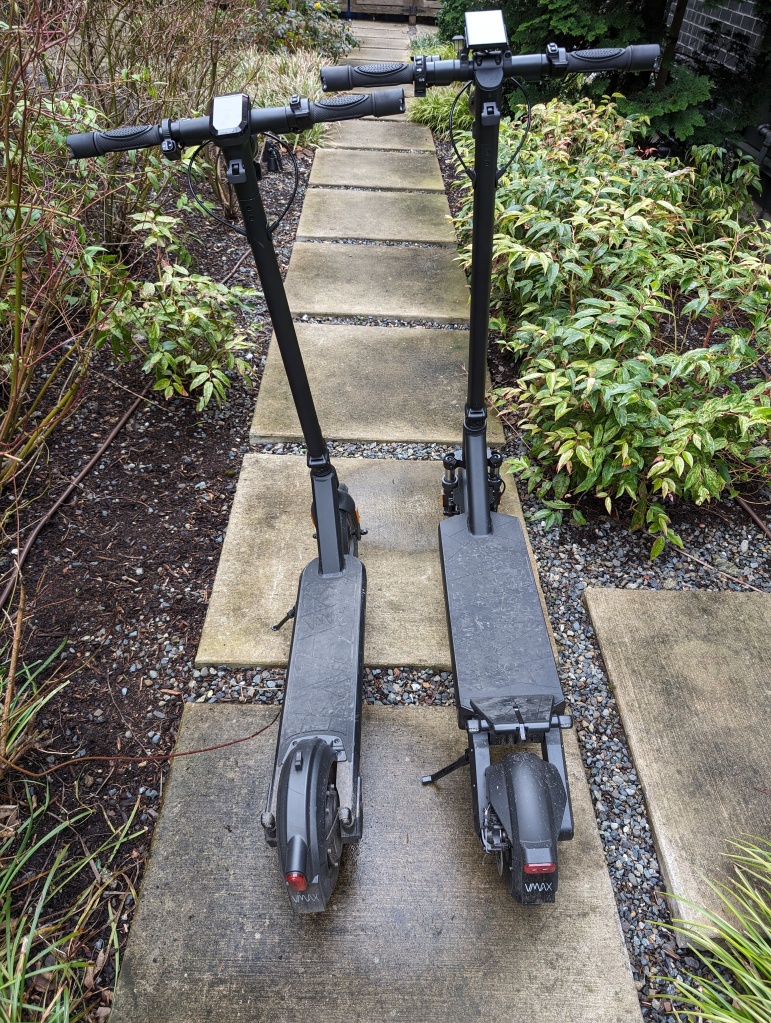
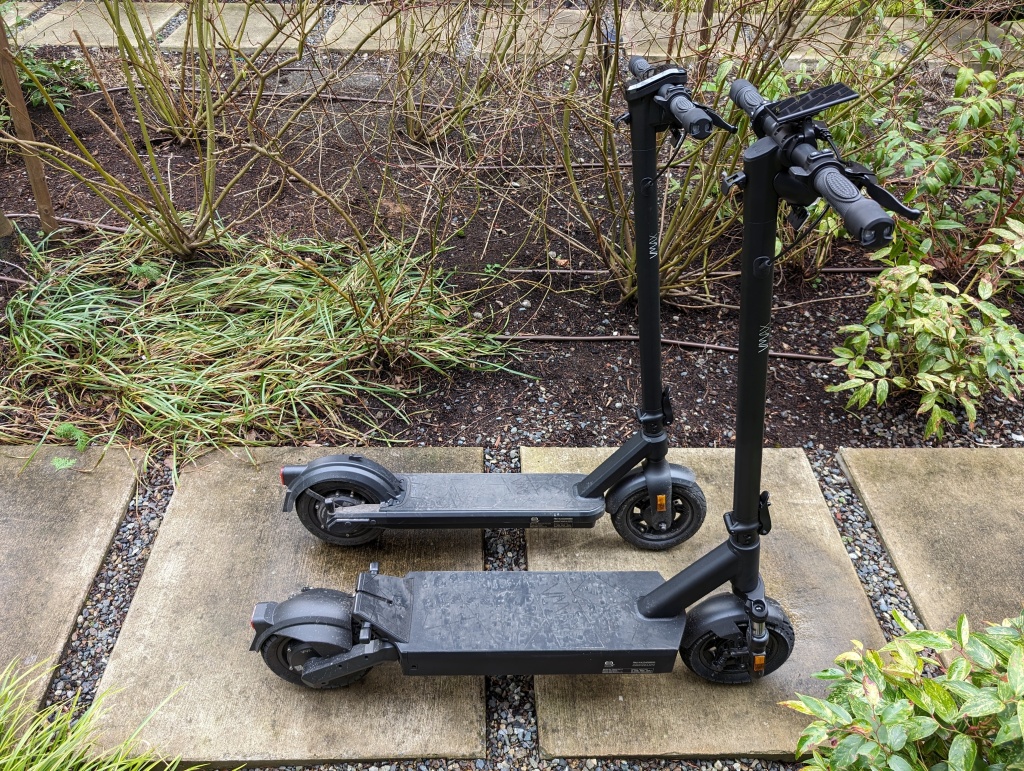
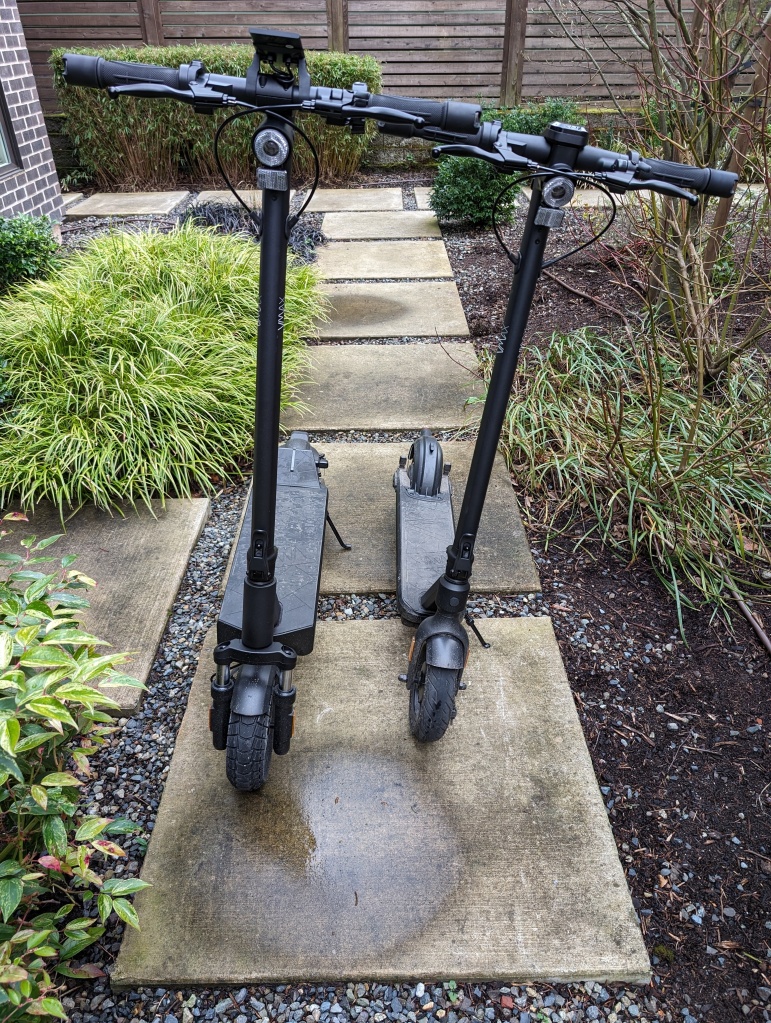
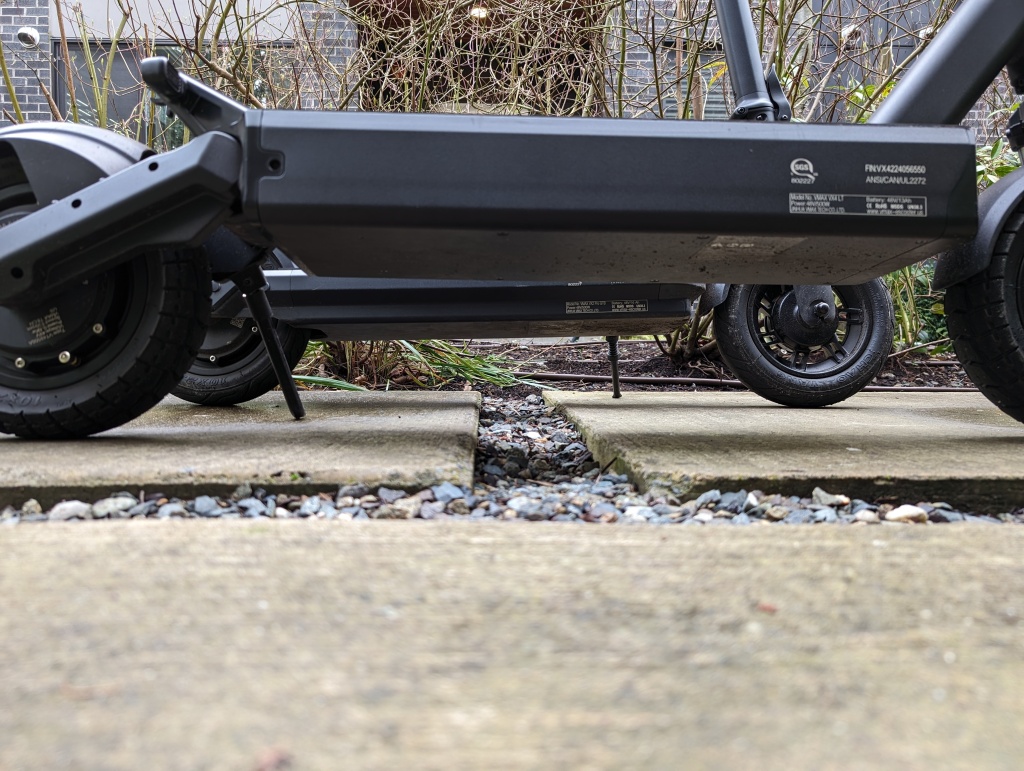
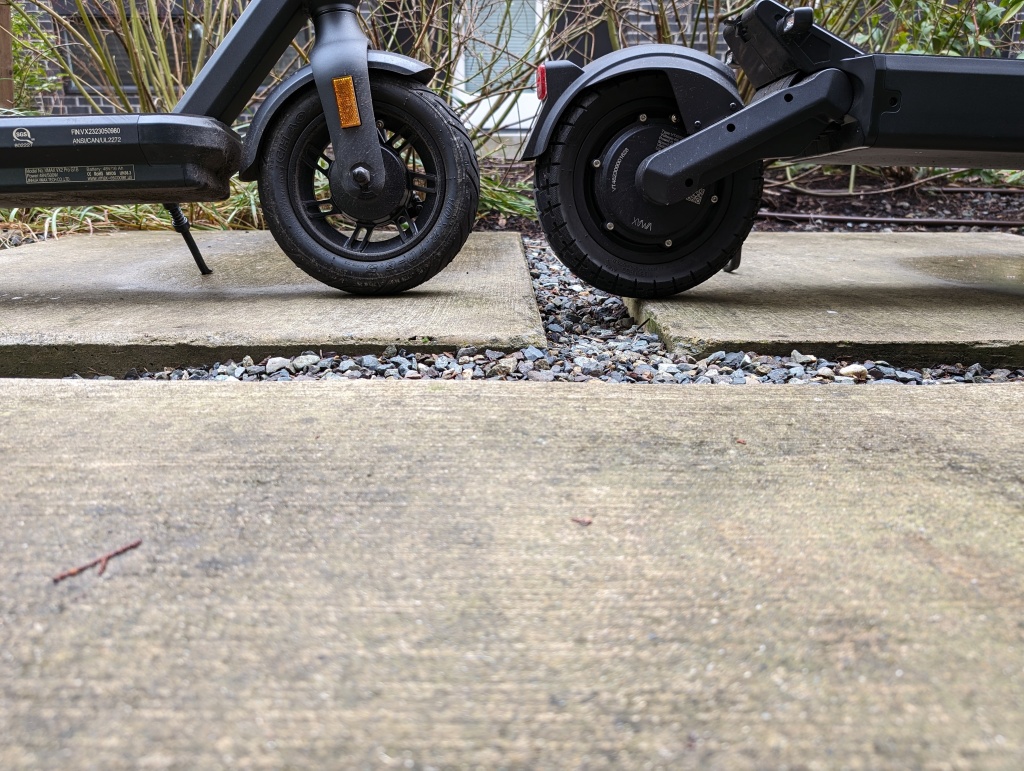
VX4 Pros (compared to the VX2 Pro)
- Slightly higher max speed (25mph vs 24mph).
- More torque (reach max speed sooner and go up hills faster).
- The max wattage on the motor is about 19% higher, which translates into a couple extra mph when going up extra-steep hills.
- The suspension! Though honestly, the suspension didn’t make as big of a difference as I thought it would. The pneumatic tires on the VX2 Pro provide a surprisingly smooth ride even without a suspension, so I would say that it’s not a must-have (though it is nice if you can afford the extra cost and weight of the VX4).
- The tires seem like they have better grip and are less likely to skid on asphalt, especially wet asphalt. The VX2 Pro tires handled wet asphalt worse than Lime gen 4 scooters, in my experience.
- The VX4 feels more “stable” than the VX2 Pro, as though it requires less effort to keep from falling off it. Though they don’t feel quite as stable as the gen 4 Lime scooters, for comparison purposes.
- On the VX2 Pro, neither the rear regen brake nor the front drum brake (even on max “tightness”) can bring the scooter to a complete stop. This is especially noticeable on hills. Once you get down to like 1-2 mph, you’ll have to stop the rest of the way (and stay stopped) with your feet. The VX4 fixes this problem, as the rear disc brake is more effective and works at all speeds.
VX4 Neutral Points (compared to the VX2 Pro)
- The VX4 is 5 inches taller and 4.5 inches longer and the VX2 Pro. The extra height is partly from the suspension (giving it a higher ground clearance) and partly from the adjustable screen (which can make the scooter taller depending on how you angle it).
- The front brake is on the right for the VX4, but on the left for the VX2 Pro.
- I found it very odd that they were opposite from each other! I usually use the rear brake for general braking (to make use of the regen) and both brakes at once for harder braking, and I personally didn’t have much trouble switching over, so no big deal to me. In fact, I like it better, because I can use my right hand for throttle, and my left hand for primary brake (instead of using my right hand for both, while also trying to hold the handle, which is a little difficult).
- VX4 looks a bit less “slick” than the VX2 Pro due to the chunky, boxy footboard/deck and non-integrated “bolted-on” screen. Though on its own, it looks fine. The VX2 Pro just happens to look especially cool.
- Also no good electronic locking mechanism.
- Unlike the VX4 Pro’s 4-digit PIN mechanism, the VX2 only allows locking through the companion app. The app allows you to lock/unlock your scooter with the push of a button, but literally anyone with the app can connect to your scooter and unlock it, which is a major security oversight; there’s no password or account tied to the lock. It simply requires connecting via bluetooth and hitting the “unlock” button in the app.
- And oh yeah, the Android app takes quite a long time (>20 seconds) to connect on bluetooth anyway, often requiring clicking the “rescan” button multiple times (at least on my Pixel 8). And it seems to not work reliably if you have bluetooth headphones connected to your phone already. One time, it took so long to connect that I thought it never would, and that it would stay permanently locked! I stopped using the feature after that.
VX4 Cons (compared to the VX2 Pro)
- The folding system.
- The upper lock (which keeps the stem vertical) on both scooters is robust and easy to use. It feels sturdy and like it wouldn’t accidentally come undone or break, while also being easy to engage and disengage.
- However, the lower lock lock (which keeps the stem horizontal, for storage or carrying) on the VX4 is lacking when compared to the VX2 Pro (which has a great one). The VX2 Pro’s lock is easy to attach (just fold it down and push the hooks together with a single hand) and detach (just pull back the stem’s hook and unfold it). The VX4’s mechanism, on the other hand, requires awkwardly pushing the footboard’s hook a very specific distance and holding it there with one hand, while simultaneously aligning the stem’s hook with it with the other hand, and then just scraping them together until they click into each other. And then it automatically unhooks as soon as you remove upward pressure, so it just falls apart if you try to e.g. fold it and then push/slide it under a desk or something. You have to slide it while maintaining adequate upward pressure the entire time (which is not easy), and then hope it’s stable enough in its final resting place so the handlebars don’t twist off to the side. And then pulling it back out is of course very difficult as well, since the lock is no longer engaged at all at that point. So the lower hook on the VX4 is basically only usable for carrying, not for storage. And believe me, at over 60 lbs, the VX4 is NOT easy to carry!
- However, if you pull the lower hook up and then jam a pen underneath it to keep it sticking out, the latching system functions identically to the VX2, requiring only one hand and no fiddling. VMAX support said they are actually working on a custom part for this that they will eventually offer to customers, so they won’t need to use pens any longer.
- VX2 Pro appears slightly more water-resistant, especially around the screen area.
- The VX4 screen has wires going into a hole in the top that water could easily fall into as well, filling the stem with water eventually. I’ll probably fill this hole with silicone caulk at some point. However, I haven’t had any problems yet—though I’ve only ridden the VX4 in light rain for short periods, and I dry the scooter in front of a fan afterward.
- I might also consider installing a cover over the main screen, just to be safe.
- The turn signal buttons on the VX4 are difficult to use without looking, as it’s hard to tell when your finger is on the correct button (or even on a button at all). There are some very small raised bumps, but they’re impossible to feel with gloves on. In contrast, the VX2 Pro’s turn signal unit sticks out from the handlebars and has a much more tactile rocker switch, so it’s much easier to manipulate “by feel”—though it’s also a little difficult to turn off reliably, since it’s a 3-way rocker switch; you have to put it into the middle position to turn it off, and if you push it too far, you end up turning on the opposite turn signal instead of turning it off. I’ve found that pushing my entire thumb onto the middle helps reset it without going too far in either direction.
- The VX4 always starts in Eco mode, while the VX2 Pro remembers whether you were in Eco mode or Sport mode. Minor nit, but still worth mentioning.
- The VX2 Pro is cheaper, lighter, and more compact.
Which one should you get?
The reason why I went with the VX4 is because I live in a hilly, rainy area with really crappy, bumpy, pothole-filled roads. So I needed the extra power, better tires, and full suspension. But if you live in a flat area with smooth roads, the VX2 Pro is probably plenty for you. And if you don’t need the full 24mph speed or 22 mile range of the VX2 Pro, you could even go with one of the cheaper models like the VX5 or VX3 Pro.
Conclusion
Overall, it seems like VMAX really nails it on integrating all of the most important features of a scooter (safe UL-certified battery, turn/brake lights, good hill climbing, good max speed, redundant brakes, regen braking, water resistance, suspension). That’s ultimately why I went with VMAX for my first scooter, despite how relatively unknown they are in the US market. I took a chance on them, and I think they really delivered. I’m quite a happy customer!
But they could improve in terms of build quality, as well as polish on their UI, website, datasheets, and manuals. You shouldn’t need to contact support to get basic info about how to actually enable the ability to travel at max speed; it should just be in the manual or the UI. And for a $1200 scooter, they really should be spending a few extra cents on screws that don’t strip.
Don’t get me wrong—despite how long my list of minor lowlights was, I am still very happy with this scooter, and if I had to guess, most other scooters would probably fare even worse after receiving such a nitpicky review from myself. There’s a reason why I went with VMAX—I did a ton of research. Like, dozens of hours. Ultimately, no scooter is perfect, but from what I can tell, I think I did good with trusting VMAX for my daily commute.
Update: Comparison to the NIU KQi 300X
A solid-looking competitor, the NIU KQi 300X, just came out right around the time this post did. It’s a similar-looking scooter in a similar price range, but with a few key differences:
- Slightly less max power (1000W vs 1300-1600W)
- Slightly lower max speed (20mph vs 24-25mph)
- Slightly less water resistance (IPX5 vs IPX6)
- Suspension only on the front (but that’s where it matters most).
- Slightly larger tires (10.5″ vs 10″)
- $840 (vs $1000-$1200 for a VX2 Pro or VX4 model with about the same 37-mile range)
Overall, it’s a tough call! But for me, I think I appreciate the extra power and water resistance of the VX2 Pro/VX4 for my hilly, rainy city.
Bonus: How to activate hidden features
Both the VX4 and VX2 Pro have some hidden features that can’t be accessed through the normal settings and are not mentioned in the manual or on the website. I have figured out how they work through a combination of support requests and trial-and-error:
- Beast mode: Increases the speed limit (from 15mph to 24mph on the VX2 Pro, and from 21.7mph to 25mph on the VX4). To activate:
- VX2 Pro: Press the power button 5 times. The display will show “13”. Hit the throttle once. It will now show “2”, for “enabled” (“1” is “disabled”). Then hit the power button 5 times again.
- VX4: Press the power button 5 times. There will be no confirmation beep or change on the display, but it will be enabled.
- Cruise mode: Keeps the throttle on so you don’t have to hold it. To activate:
- VX2 Pro: Press the power button 3 times.
- VX4: Press the power button 3 times. There will be no confirmation beep or change on the display, but it will be enabled.
- This does NOT set your current speed as the “cruise” speed, like it does in cars. Rather, I have noticed that if you have cruise mode enabled and have been at max throttle and the same speed for several seconds in a row (maybe 5-10 seconds), then you can release the throttle and it will stay at max throttle automatically, turning off if you brake or use the throttle again.
- Kick-start mode: Changes whether the throttle works from 0mph or ~2mph. To activate:
- VX2 Pro: Press the power button 4 times.
- VX4: Not hidden; it’s in the settings!

